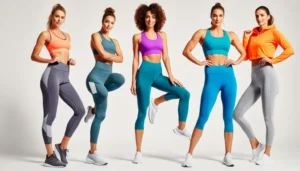The global yoga apparel market, now valued in the billions, is undergoing a significant transformation as environmentally conscious brands take center stage. In 2024, a notable surge in sales of eco-friendly yoga wear marked a turning point for an industry once dominated by synthetic fabrics and fast fashion models. This consumer-driven shift reflects growing awareness around sustainability, ethical production, and personal wellness—values that deeply align with the philosophy of yoga itself.
Industry analysts report that eco-conscious activewear brands have experienced a double-digit increase in sales over the past year, outpacing traditional competitors. Shoppers are no longer just looking for comfortable leggings or breathable tops—they want products that reflect their values, support the planet, and deliver long-term quality.
A Market on the Rise
Yoga apparel has evolved far beyond its original niche. What once consisted of basic cotton clothing has blossomed into a dynamic, high-growth sector encompassing everything from leggings and bras to mats, bags, and outerwear—all designed for yoga practice and athleisure wear. According to a 2024 report by Global Market Insights, the global yoga apparel market is projected to reach over $44 billion by 2028, driven by increased participation in wellness activities and a rising demand for fashion-forward, functional gear.
However, alongside this growth, consumers have begun asking deeper questions: What is this product made of? How was it produced? Is it biodegradable or recyclable?
This shift in mindset has created space for a new wave of companies offering sustainable alternatives to petroleum-based fabrics like polyester, nylon, and spandex—materials that have long dominated the market but contribute heavily to environmental degradation.

Sustainability: The New Selling Point
Eco-friendly yoga apparel brands are not just following trends—they are setting them. Labels like Girlfriend Collective, Wolven, Pact, Boody, and Outdoor Voices have built strong reputations by using recycled plastics, organic cotton, bamboo fibers, and low-impact dyes. These materials minimize environmental harm while maintaining the flexibility, moisture-wicking properties, and style that modern consumers expect.
For example, Girlfriend Collective transforms post-consumer water bottles into leggings and sports bras, while Wolven blends recycled PET with modal made from sustainably harvested beechwood pulp. Both brands provide transparency about their supply chains, pay fair wages to factory workers, and offset carbon emissions through reforestation programs.
Their efforts are paying off. Girlfriend Collective reported a 35% year-over-year increase in online sales, while Pact’s direct-to-consumer model continues to attract millennials and Gen Z buyers—demographics most concerned with climate change and corporate responsibility.
The Influence of Conscious Consumers
Today’s consumers, especially younger buyers, want more than comfort and style—they want their purchases to align with their environmental values. A recent survey by NielsenIQ found that over 73% of global respondents prefer brands that actively support environmental causes. Within the yoga community, where mindfulness, self-awareness, and ethical living are foundational principles, this preference is even more pronounced.
Social media has amplified this trend. Influencers, yoga teachers, and eco-conscious lifestyle bloggers regularly showcase outfits made by green brands, often explaining the benefits of biodegradable fabrics and sustainable production methods. Hashtags like #SustainableActivewear, #EcoYogaStyle, and #MindfulFashion are gaining momentum, helping consumers make informed choices and fostering community around sustainable wellness practices.
The Problem With Traditional Yoga Wear
Despite the recent eco-shift, much of the yoga apparel industry still relies heavily on conventional materials derived from fossil fuels. Polyester and nylon are not only non-biodegradable but also release microplastics into water systems every time they are washed. These microplastics pose significant risks to marine life and, ultimately, human health as they move through the food chain.
Moreover, the production of synthetic fabrics often involves toxic chemicals, large quantities of water, and poor labor practices. In contrast, sustainable brands emphasize closed-loop systems, safe working conditions, and reduced water consumption—factors that are increasingly swaying the decisions of environmentally aware customers.
Big Brands Catching Up
The growth of eco-conscious startups has not gone unnoticed by industry giants. Major players such as Nike, Lululemon, and Adidas have launched sustainability initiatives to capture this shifting market. Lululemon, for instance, has committed to using 100% sustainable materials by 2030 and introduced its first line of yoga pants made from plant-based nylon in 2024.
Nike’s “Move to Zero” campaign includes yoga-specific collections made from recycled polyester and sustainable cotton, while Adidas collaborates with organizations like Parley for the Oceans to produce garments from ocean plastics.
Though some critics argue that these efforts may be examples of “greenwashing,” the trend itself signals a fundamental shift in industry norms, encouraging all players to adopt cleaner, more ethical practices.
Challenges Ahead for Sustainable Brands
While consumer demand is rising, eco-friendly yoga apparel companies still face several hurdles. Sustainable fabrics tend to be more expensive to source and produce, which can drive up retail prices. Small and mid-sized brands must strike a delicate balance between affordability and ethics, especially when competing with fast fashion giants that undercut prices.
Additionally, scaling up production without compromising environmental and labor standards remains a challenge. As demand grows, maintaining transparency and sourcing integrity becomes critical to brand reputation.
Nevertheless, many in the industry remain optimistic. Advances in textile technology, such as biodegradable synthetics and bio-based fabrics, are opening new doors. At the same time, policy shifts and environmental regulations in Europe and parts of North America are pushing manufacturers toward more sustainable models.
The Future of Yoga Wear: Style Meets Responsibility
Looking ahead, the yoga apparel industry appears set for a greener future. As yoga continues to grow in popularity—embraced not just as an exercise, but as a holistic lifestyle—consumers will likely become even more selective about the brands they support. Eco-friendly yoga wear will increasingly reflect not only fashion tastes but also a person’s ethics, beliefs, and values.
Retailers and manufacturers who ignore this shift risk falling behind, while those who embrace it stand to gain loyal, passionate customer bases. Whether through recycled leggings, organic cotton tops, or carbon-neutral shipping practices, the message from consumers is loud and clear: sustainability is no longer a luxury—it’s a necessity.
In this rapidly evolving market, the brands that thrive will be those that recognize the full meaning of yoga—not just as a practice on the mat, but as a way of life that embraces harmony with both the self and the Earth.





